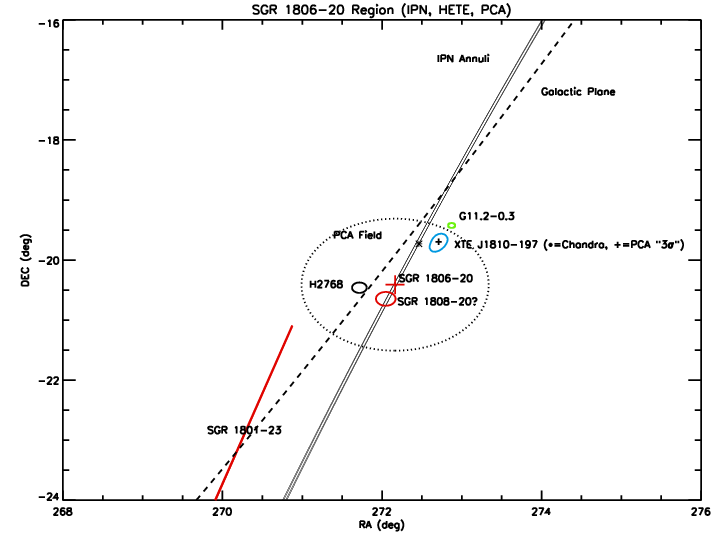XTE J1810-197 - Position and Fluxes of New 5.54 s pulsar

NOTES:
* Chandra position from Gotthelf et al. 2003 (IAUC 8190 [when available by web])
R.A. = 18h09m51.13 { J2000
Decl. = -19o43'51.7 { error radius 2.1"
* IPN Annuli from Hurley et al. 2003 (GCN 2297)
* HETE Error Region of burst H2768 from Hurley et al. 2003 (GCN 2308)
* SGR 1801-23 Error Region from Cline et al. (2000, ApJ, 531, 407)
* Reported position of potential new SGR 1808-20 (H2802; GCN 2351)
XTE J1810-197 - Position and Fluxes of A New 5.54 s pulsar
C. B. Markwardt (U. Md. & GSFC), A. I. Ibrahim (GWU), J. H. Swank (GSFC)
In Ibrahim et al. (GCN #2306), we reported the presence of a 5.54 s
pulsar, detected in the RXTE PCA field of an observation of SGR
1806-20. At the time, we speculated that the pulsar could either be
the source of soft gamma repeater bursts seen by the IPN (GCN #2297);
or, a previously unknown pulsar simultaneously active with the known
SGR 1806-20. Since then, Hurley et al. (GCN #2308) have concluded
that HETE data agree with the IPN that SGR 1806-20 is the likely
source of the bursts.
An RXTE PCA scanning observation was performed on Jul 18.23-18.27
(UT). A new source was detected, whose position is, R.A. = 18h10.9m,
Decl. = -19o42' (equinox 2000.0), with estimated 99% confidence
semi-major axes of 5' in R.A. and 7' in Decl. This confidence region
is not consistent with either the IPN burst annuli (GCN #2297) or the
HETE burst error region (GCN #2308), or with any other known pulsar of
that period. Thus, we designate this new source as XTE J1810-197.
The best fit position is 21' from the galactic plane. See above for
the figure.
The fitted flux of XTE J1810-197 was 2.5 +/- 0.2 mCrab (2-10 keV),
which is comparable to flux of SGR 1806-20 (1.1 +/- 0.1 mCrab) and the
galactic diffuse emission (2.9 mCrab), which are also in the field of
view. Assuming a distance of 8.5 kpc, the luminosity is approximately
10^{36} erg/s.
In retrospect, the source has been present in the RXTE PCA galactic
bulge monitoring program at the very edge of the scan region since Feb
7, and has declined steadily from an initial flux of 3.6 mCrab (2-10
keV).
The spectra of the sources were deconvolved by selecting light curves
of different energy bands and fitting the source intensities while
holding the positions constant. The resulting spectrum of XTE
J1810-197 is consistent with a power law of photon index ~4. Such a
soft spectrum is not typical of high mass X-ray binaries, and based on
the pulse period, one might speculate that it is an anomalous X-ray
pulsar. On the other hand, the long term light curve is more typical
of a transient pulsar in an X-ray binary.
BRIEF IAUC VERSION
C. B. Markwardt, University of Maryland and Goddard Space Flight
Center (GSFC), A. I. Ibrahim (The George Washington University),
J. H. Swank (GSFC), report: "In response to the report of burst
activity (GCN 2297) and the detection of an unexpected 5.54 s period
pulsar, we obtained an RXTE PCA scanning observation on Jul
18.23-18.27 (UT). A new source was detected, whose position is,
R.A. = 18h10.9m, Decl. = -19o42' (equinox 2000.0), with estimated 99%
confidence semi-major axes of 5' in R.A. and 7' in Decl. This
confidence region is not consistent with either the reported IPN burst
annuli or HETE burst error region (GCN 2297, 2308), or with any other
known pulsar. Thus, we designate this new source as XTE J1810-197.
The fitted flux of XTE J1810-197 was 2.5 +/- 0.2 mCrab (2-10 keV). In
the RXTE PCA galactic bulge monitoring program, the source is
detectable since Feb 7, 2003 (but not before), and is steadily
declining from a maximum of 3.6 mCrab. Follow-up observations are
encouraged.
MODIFICATIONS
16 Aug 2003 - Change name to XTE J1810-197
16 Aug 2003 - Update to figure shows more sources
05 Sep 2003 - Update figure and text to include Chandra position
